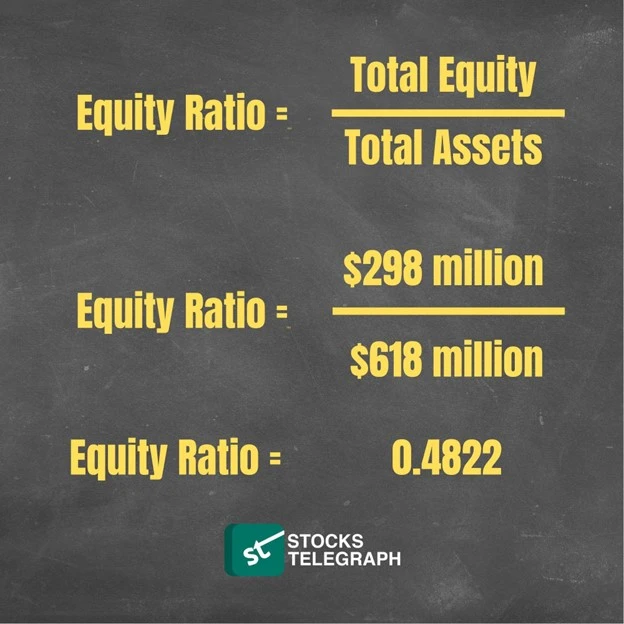The equity ratio is a vital resource for market participants, which helps provide valuable insight into several critical domains that relate to a company’s financing.
For any investor, some of the most critical questions arise regarding the company’s financing structure, its debt coverage, how much shareholders actually own, and how stable its financial prospects are.
One of the most reliable ways to get an objective outlook on these questions is by turning to the ratio of equity, as it delivers a bird’s eye view of these broad and fundamental questions.
Both investors and creditors turn to this metric to determine the leveraging strength of a particular company, before deciding to commit funds to it.
It thus is a reliable measure of financial strength and helps instill confidence in the broader group of stakeholders that relate to the company.
In this article, we delve into exactly what the equity ratio is, and how you, as a market participant can employ this tool to better guide your investment decisions.
What is the Equity Ratio?
The equity ratio is a calculated financial metric that assesses the financial strength of a chosen company, as well as the degree to which it is able to pay off its debt obligations.
It is one of the most important domains of financial management and relates to how sustainable a company’s financials are to keep it afloat into the long-term future.
The ratio precisely indicates the proportion of a company that is financed by the contribution of shareholders, who are essentially the owners of the company, relative to the portion attributable to debt holders and creditors.
Because of the ratio’s direct capability of pointing out the shareholders’ strength in the company, it is also referred to as the shareholder equity ratio.
The usefulness of the ratio covers a broad range of parties, including investors and creditors, who determine the relative safety of a company by determining how well-leveraged its financial position is.
The ratio is used extensively by internal finance departments to guide budgeting and capital allocation decisions in a manner that shareholder value is maximally prioritized.
This crucial metric is also perceived as a reference point during negotiations on mergers and acquisitions. The widescale application of this simple ratio emphasizes its seemingly basic function, along with its critical importance.
How to Calculate the Equity Ratio?
In terms of its calculation, the equity ratio is calculated by dividing a company’s total equity by its total asset base, which gives a proportionate figure on the shareholder’s claims on a company.
Because of the manner in which this proportionate figure is calculated, the ratio is often called the equity-to-asset ratio.
The total asset figure in the calculation is derived from the company’s balance sheet and includes all asset classes such as current, non-current, and even intangible assets.
The equity portion is made up of the sum of the shareholder’s equity, such as paid-up capital, ordinary stock, and preferred stock, and all earnings that have been retained rather than distributed.
Because each of the variables in this calculation is primarily based on the balance sheet, as opposed to the income statement, the equity-to-asset ratio presents its users with a snapshot in time, rather than performance over a specific time frame.
Equity Ratio Formula
The formula for the ratio of equity stands as being among the simplest of formulas, as described above, and is expressed simply by dividing the total equity of a company by the total value of assets reported on its balance sheet.
As a formula, this would be as follows:

Because each of the variables mentioned is part of our ratio, we can further break down the total equity and total assets part of the formula to shed light on how this calculation is to be performed.

The total equity part of the formula consists of the money pooled in by the shareholders of the company, which includes the cumulative sum of all the paid-up capital, ordinary shares, and preference shares.
In addition to all the money put into the company, it also consists of their claim of profits that have been retained in the business, and not yet distributed.

As can be seen in the sub-formula showcased above, the asset part of the ratio will be inclusive of every asset class reported in the company’s balance sheet, including intangible assets.
Equity Ratio Calculation Example
We now take a look at a real-world example to contextualize the ratio of equity discussed above, in order to step beyond the realm of pure theoretics and get hands-on with the ratio itself.
To do so, we stop to assess the balance sheet of the digital media company, Buzzfeed Inc. (NASDAQ: BZFD).
Based on its latest reported figures, we can see that the total assets of the company amount to $618 million, which includes its cash holdings, equipment, investments, and intangibles, among others.
Alternatively, Buzzfeed’s total equity figure works out to $298 million, after incorporating both the controlling interest and the minority stakes in the company.
The shareholder equity ratio for this example is calculated as follows:

The ratio thus amounts to 0.4822 which means that the shareholder’s portion of the company’s financing exceeds 48% whereas the remaining 52% is sourced by external debt and obligations.
How to Interpret the Equity Ratio
Although the calculation of equity ratio is a straightforward process, its interpretation can be relatively more complex.
This is because it requires the input of additional contextual information to make sense of the figure presented by the ratio.
The following factors must be considered when one interprets the ratio of equity:
-
Higher ratio means a stronger financial position
When the ratio of equity is high, it brings confidence to investors. This is because it shows limited exposure to external creditors, whereas the bulk of the company is built up from the contributions of its owners.
-
Low ratio means more financial risk
A low ratio of equity means that the company’s financing mostly comes from debt, and therefore outsiders have a claim to assets if the company fails on meeting its payment obligations.
-
There is no one-size-fits-all
It is important to note that different industries would have different ranges of acceptable ratios, so a comparative peer analysis could deliver useful insight.
-
The lifecycle stage of the company must be considered
As a company excels in its performance and grows over time, it tends to improve its ratio of equity, as it turns to additional rounds of equity financing.
It does this while simultaneously growing income and systematically cutting off debt.
How to Determine the Financial Health of A Company?
-
Analyze the Balance Sheet
The balance sheet is one of the foremost areas that is looked into during an assessment of a company’s health, as it reports the snapshot standing of a company’s assets, liabilities, and shareholder’s equity.
This information is crucial, as it looks at the leverage of a company, along with liquidity position and solvency.
-
Analyze the Income Statement
The Income Statement is more focused on business performance, and investigates revenue and expenditure, along with profits and losses.
It helps point out how profitable and efficient a company is, and thus is fundamental to determining its financial health.
-
Analyze the Cash Flow Statement
A financially healthy company is one that soundly manages its cash resources and liquidity position.
The cash flow statement is a report that is used precisely for this analysis and delivers critical insight that relates to the cash inflows and outflows relating to the company over a specified time span.
-
Financial Ratio Analysis
Financial ratios are among the most effective tools designed to gauge the financial strength of an entity while allowing for quick and straightforward assessments.
Different ratios are used to investigate different financial domains of a company, and can thus aid in decision-making.
The Best Measures Of A Company’s Financial Health
-
Revenue growth
Revenue growth, also referred to as top-line growth is the number one performance metric that analysts tend to look at.
It tells one how much a company has improved over time in generating more sales, and is thus capturing a greater market share.
-
Gross profit margin
The gross profit margin is a great assessment tool as it relates to a company’s business efficiency, or its ability to optimally derive profit from its overall revenue.
It is especially crucial in determining a company’s ability to maximize shareholder value. -
Operating profit margin
The operating profit margin is yet another efficiency metric, but unlike the gross profit margin, takes a more specific focus on the operational side of the business.
After considering operating costs and operating income, it is able to give a clear picture of how efficient current operations stand. It is also used to track improvement over time.
-
Debt-to-Equity ratio
The debt-to-equity ratio is an important tool in assessing the financial health of a particular company, especially in relation to its leverage.
As a ratio, this figure points out how balanced a company’s finances are between debt and equity. It reveals an overreliance on external debt, which could enhance the risk of bankruptcy.
Unlike the total liabilities to equity ratio, the debt to equity ratio only considers long-term debt, while excluding short-term liabilities.
-
Liquidity ratios
One of the most critical measures of a company’s financial robustness is how ready it is to address its immediate obligations, based on its present cash holdings.
Analysts assess cash management by turning to liquidity ratios, which assess the cash, and assets it can immediately convert into cash, against current payables.
-
Return on Equity (ROE)
Return on Equity is a tool for ascertaining the financial wellness of a company that shareholders are especially concerned with.
It reports to them how efficient the company has been on the basis of equity.
Using the ROE, investors compare which is the best stock to park their funds in, in order to receive the highest possible return. -
Cash flow
Cash flow is crucially linked to a company’s financial viability, as it presents a picture on how well the company is managing its cash resources, as they flow into and out of the company.
Healthy levels of cash flow allow for smooth business sailing which is not obstructed by non-payments of current obligations.
Conclusion
The equity ratio is one of the handy tools for market participants to turn to, which delivers a broad view of a company’s financial health.
It does so by assessing the total assets in the balance sheet, and determining what portion of this figure is attributable to shareholders only, by excluding the debt portion of the finances.
It sheds light on the company’s financial leverage and therefore acts as a strong predictor for financial sustainability.
Any financial assessment of a company that omits this fundamental aspect would always portray an incomplete picture of its financial health.
FAQs
-
What is a good equity ratio?
As a general rule of thumb, the higher the equity ratio of a company, the more stable its financial position is, as its reliance on external debtors is largely limited.
Not only does a company with a high ratio of equity have a low bankruptcy risk, but also does not bear the burden of heavy interest payments.
The specifically ideal ratio would vary across industries, the scale of operations, and the nature of business.
-
What are the total liabilities to equity ratio?
The total liabilities to equity ratio is a financial metric that allows market participants to gauge how well-balanced a company’s total liabilities are against the total capital of shareholders.
Unlike the debt to equity ratio, the ratio of equity incorporates all liabilities, including short-term payables, and is said to be a fairer assessment, on account of the inclusion of short-term assets.








